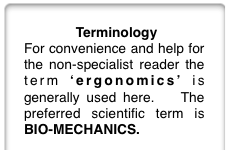 Ergonomic Office chairs.
Ergonomic Office chairs.
- This work is intended to explore the bio-mechanical (ergonomic) factors that may determine spinal pathology that results in spinal dysfunction which includes Backache, Low Back Pain & more serious breakdown of spinal components.
- Once identified, corrective measures can be developed to be incorporated into both design & remediation for sitting safely in any ergonomic chair. The commonly misconceived views can be avoided.
- A fully optimised design concept for an ergonomic chair is suggested as a complete solution.
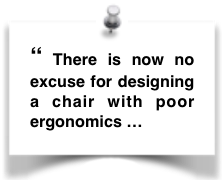 It is intended as a resource for the designers of ergonomic or office work chairs, whether of the conventional upright office chair type or more modern concepts.
It is intended as a resource for the designers of ergonomic or office work chairs, whether of the conventional upright office chair type or more modern concepts. 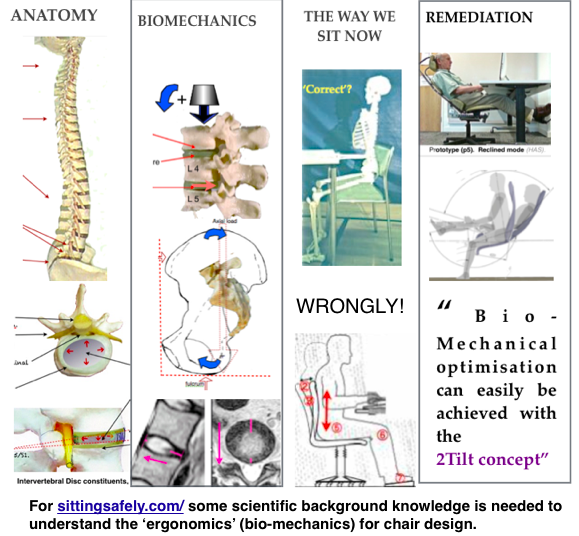

- Correct ergonomics are the essential and fundamental requirements for any chair design and also determine comfort.
- Misconceived views can be avoided. Designers seem to have difficulties with the science behind ergonomics judging by the surprising number of poor ergonomic chairs in the market. ☛ Why?
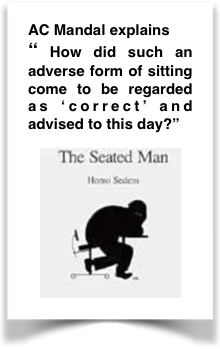 And the poor, even wrong, advice offered.
And the poor, even wrong, advice offered.- Most ergonomic chairs are upright and only susceptable to partial remediations of the adverse effects of The upright seated posture.
- Whether partial or full the basic ergonomic requirements for ergonomic chairs for Sitting safely is described under ☛REMEDIATION →
- The fully optimised concept involves a reclined work-mode and is the ☛The 2Tilt concept, the ultimate remediation →
- This fully optimised design concept, suggested for an optimal solution to Low Back Pain, provides a resource for chair designers of ergonomic chairs and, indeed, of any chair..
- It is also very relevant for manufacturers of retail office ergonomic chairs if they wish to improve the ‘ergonomics’ of their ergonomic chairs with overwhelming health selling points.
- And to Interior designers and architects involved with office design and not forgetting the ‘end user’ who has the ultimate benefit and may be suffering from Back Pain .
For navigation & overview of of contents…..
This is indicated in the top menu↑. Most posts are shown in the menu on the right→ ( a few can only be accessed through the page from which they are derived).
 Specialists may prefer to jump directly to their page of interest using the Right menu→. See the SPECIALIST page → This includes a large body of research and background, on spinal bio-mechanics. The essential reading is :-
Specialists may prefer to jump directly to their page of interest using the Right menu→. See the SPECIALIST page → This includes a large body of research and background, on spinal bio-mechanics. The essential reading is :-
- The SCIENCE
- BIOMECHANICS that determine safe sitting
- PALEO-ANTHROPOLOGY
- REMEDIATION
- 2T CONCEPT a full solution

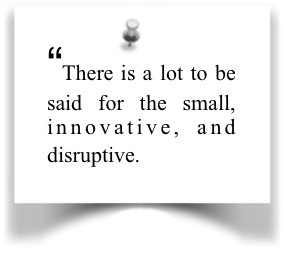 Manufacturers can be reassured that feasibility indicates that existing components can be used , avoiding the expense of retooling, while preserving their brand image. Prospective manufacturers can be helped to leap ahead of the field, New ideas can create both threats and opportunities , once both familiarity and normalcy biases are overcome. Creative disruption works.
Manufacturers can be reassured that feasibility indicates that existing components can be used , avoiding the expense of retooling, while preserving their brand image. Prospective manufacturers can be helped to leap ahead of the field, New ideas can create both threats and opportunities , once both familiarity and normalcy biases are overcome. Creative disruption works.
For New offices ‘Coolness’ is the word to excite media interest for both the company and the Architect/Designer. Most firms aspire to project this cutting edge image. A 2T chair, or the derived 4M workstation, answers this exactly and in addition reduces LBP and increases productivity by lessened morbidity and stress. ( Also see ☛ Ergonomics and office stress.→ )
 Office managers should consult this blog as a resource. It allows an alternative view to the usual hype, often laughably misguided, from manufacturers,
Office managers should consult this blog as a resource. It allows an alternative view to the usual hype, often laughably misguided, from manufacturers,
And not forgetting the interest of all chair users ……

 Backache & chairs. A number of systems are described. Spinal bio-mechanics dictates that prolonged Sitting safely should be performed in a reclined position with frequent change of posture. For a full remediation a number of requirements are essential. To be effective these are detailed in the 2 Tilt (2T) concept.
Backache & chairs. A number of systems are described. Spinal bio-mechanics dictates that prolonged Sitting safely should be performed in a reclined position with frequent change of posture. For a full remediation a number of requirements are essential. To be effective these are detailed in the 2 Tilt (2T) concept.
Science, and some relevant topics
- Spinal anatomy includes a number of detailed studies of the more relevant component parts and an account of the paleoanthropology which resulted in the vulnerability of the lumbo-sacral junction. ☛ Spinal Anatomy→
- Biomechanics in relation to sitting postures. ☛ Spinal biomechanics→.
- How did we arrive here? ☛ Paleo Anthropology →
- In addition,The way we sit now, further explores present sitting including the comments (☛Why? Mandal explains…→), Gorman and others. Comparisons are made with various existing chairs (☛How do they measure up?→).
-
Ergonomic chairs – REMEDIATION
-
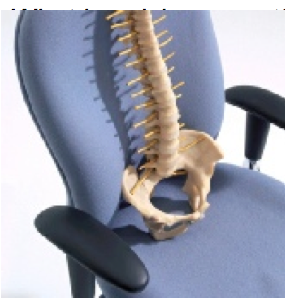 Partial solutions, the only option for an upright ergonomic chairs, include:-
Partial solutions, the only option for an upright ergonomic chairs, include:-
- ☛ Pelvic support→,
- ☛forward tilted seat→, & Ischial off-load →
- & ☛Sit/Stand→.
- ☛ Dynamic seating→Incorporating movement,
- Full solution. No chair yet in the market.
- obvious, and perhaps only, solution was for prolonged work to be performed in a chair that has a stable, correctly supported, supine reclined mode.

The big story here, however, is that it was found that a reclined mode is the only position that avoids all the adverse effects of prolonged upright sitting. For a reclined office work-chair to be practical a number of requirements are essential.
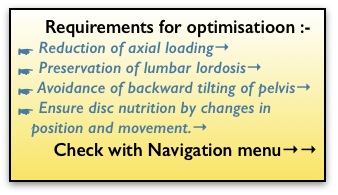 Combining these requirements can be difficult to achieve but is possible in a suitably supported reclined mode at 40-45° which conforms to spinal morphology (configuration). This alone is impractical as a work position unless a number of secondary requirements are incorporated to make this simple concept suitable and practical for sitting safely in a work chair.
Combining these requirements can be difficult to achieve but is possible in a suitably supported reclined mode at 40-45° which conforms to spinal morphology (configuration). This alone is impractical as a work position unless a number of secondary requirements are incorporated to make this simple concept suitable and practical for sitting safely in a work chair.- A
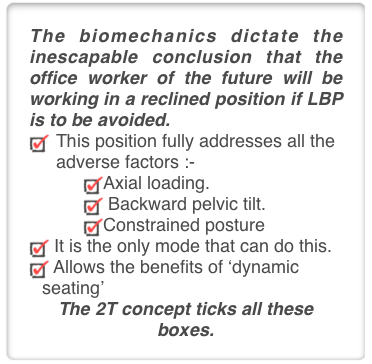 reclined mode which has a correctly supported, supine, stable position for prolonged work ☛2T reclined mode→
reclined mode which has a correctly supported, supine, stable position for prolonged work ☛2T reclined mode→ - An upright mode required for certain jobs. ☛2T Upright mode→
- An unstable intermediate mode to enable a quick, easy transition between the 2T modes. ☛2T transition mode→ With the recognition that the transition movement has physiological advantages, this has been upgraded to a ‘mode’. ☛dynamic seating→. The 2T now becomes a triple-mode (3M) concept.
These 3 modes constitute the basis of the 2T CONCEPT .
A sit/stand facility can be incorporated to become a 4M version. ☛SIT/STAND (& stools)→
-
- ☛ Partial in use at present
- ☛The 2Tilt concept, the ultimate remediation →
- Also included are ☛Adjustments→, ☛comfort→, ☛ exercise and movemen→. The way things are going. ☛Special needs→, ☛the desk less office chair→, pods, school desks & chairs (See menu →).
- The office environment it’s relation to physiological and psycho-social stress, ergonomics and remediation.



